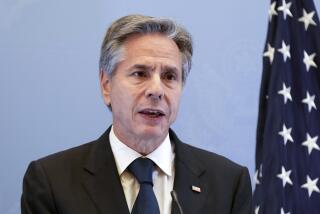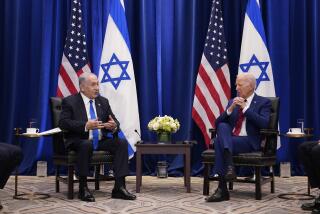Key, secret concessions opened the way for Iran nuclear deal
The talks that led to the historic deal over Iran’s nuclear program have proceeded on and off for a dozen years, but only truly came to life after two key decisions in 2013, both made behind closed doors -- one at the White House, the other, a few months later, at Iran’s imposing presidential palace, Beit Rahbari, in central Tehran.
In each case, the country’s top official decided to reverse a long-standing policy, taking significant risk to open space for negotiations. In gambling that the time had come to seek a deal, President Obama and Ayatollah Ali Khamenei broke a stalemate that had made the years of on-and-off negotiations an exercise in frustration.
The rut in which talks had been stuck could be seen vividly at a meeting in Istanbul, Turkey, in January 2011. Top U.S. and Iranian officials had spoken a few days before the meeting, a rare occurrence that had raised Western hopes. But at a crucial moment, the Iranian negotiator, Saeed Jalili, refused to meet with his American counterpart at an Ottoman-era palace where the talks were to be held. Instead, he sulked in his hotel, complaining of a headache.
“Bleak, dark years” of no progress characterized most of the years of talks, said one former U.S. negotiator, recalling the fruitless discussions that began in 2002 after the disclosure of two clandestine Iranian nuclear sites stirred international alarm. For long stretches it seemed that no amount of international pressure could persuade Tehran to limit the nuclear program that was among the government’s proudest achievements.
Yet the talks never completely collapsed. They staggered on, driven by the West’s need to defuse the threat of a bomb-wielding Iran and Tehran’s need for relief from crushing economic sanctions and isolation.
This account of the path to a deal is based on interviews with dozens of key participants from Iran, as well as the U.S and other major powers involved in the talks. Most would speak only on condition of anonymity in discussing the talks. It begins when Obama came to office in 2009 and signaled his interest in reviving negotiations, sending a letter to Iran’s supreme leader, Khamenei, and Nowruz holiday greetings to the Iranian public. Although Obama insisted that he did not trust Iran’s mullahs, the first principle of his foreign policy was that contact -- “engagement,” as he refers to it -- was better than past administrations’ efforts to isolate adversary governments.
As Obama and his advisors searched in his first term for an approach that might lead to a deal, his chief Mideast advisor at the time, Dennis Ross, offered a key idea. The administration should allow pressure from economic sanctions to become as powerful as possible, Ross suggested, then float a one-time offer with the most enticing terms the U.S. would be willing to accept. Although Ross has since become a skeptic about the emerging deal with Iran, his proposal became the framework for the approach Obama followed.
Over the next several years, the U.S. and its allies ratcheted up sanctions in several steps, cutting Iran’s oil exports by more than half and largely severing the country from the world financial system.
By 2012, after his reelection, Obama decided to test whether that economic pressure had softened Iran’s resistance. He dispatched two trusted emissaries, William J. Burns, the deputy secretary of State, and Jacob Sullivan, chief foreign policy advisor to former Secretary of State Hillary Rodham Clinton, to the ancient Arabian Sea port of Muscat, Oman, to open a back channel to Iran.
First, however, Obama made a crucial decision, concluding that the time had come to offer a key concession: If the Iranians would make a deal, America would accept allowing them to continue producing low-grade enriched uranium, the substance which, at higher levels of purity, can be used as fuel for a nuclear bomb.
President George W. Bush had held a firm line against that idea. But in the late Bush years and early Obama years, more and more senior U.S. officials had come to believe that a negotiation could succeed only if the U.S. allowed Iran to continue enrichment. Iran had mastered the basics of this core nuclear capability and, after investing billions of dollars in the project and persevering through an intense U.S. and Israeli campaign of sabotage, no government in Tehran was likely to give it up, these officials believed.
The deal became possible, said Richard Nephew, a former top sanctions advisor in the negotiations, only as both sides realized they would have to accept painful sacrifices.
The Iranians “needed to feel the pain of sanctions and to realize what we could do to them,” Nephew said. “We needed to see that we weren’t going to be able to dictate terms, like we did [with Japan in World War II] from the bridge of a battleship.”
At a meeting in Oman in March 2013, Burns and Sullivan floated the new approach. Initially, the Iranians seemed uninterested. In the final years of the presidency of hard-liner Mahmoud Ahmadinejad, Iran had probed to see what the U.S. was prepared to give in sanctions relief, but had shown little interest in the kind of bargaining that could lead to a nuclear deal.
A few months later, however, in August 2013, Iranian diplomats arrived at an Omani oceanfront villa with a new message. They were now representing newly elected President Hassan Rouhani, they said, and wanted to explore whether a compromise was possible.
A relative moderate, Rouhani had based his campaign in Iran’s June 2013 presidential election on the idea of reducing the country’s conflicts with the outside world.
In a series of postelection meetings at Iran’s presidential palace, Rouhani had won the permission of the supreme leader to test U.S. flexibility, according to people familiar with the discussions. As Khamenei pointed out in a tough speech last month, he had never thought the U.S. team could be trusted -- distrust of the other side was one thing both parties had in common. Yet he gave Rouhani broad latitude to explore what could be worked out.
Importantly, Rouhani’s plans had the support of two key foreign policy advisors to Khamenei, Ali Akbar Salehi, head of Iran’s nuclear organization, and Ali Akbar Velayati, a conservative former foreign minister.
In the August meeting, the U.S. officials floated several compromise ideas. In a matter of months, after years of stalemate, those ideas turned into an interim deal, announced in November, which set rules for the subsequent two years of negotiations. That so-called Joint Plan of Action gave Iran limited, temporary relief from sanctions in exchange for stopping some of its most worrisome nuclear activities, particularly its production of more highly enriched uranium.
The breakthrough in Muscat did not make the bargaining easy or certain. The negotiations have remained contentious and seemingly always moments away from collapse.
“It’s been a roller coaster,” said a senior administration official, one of hundreds of U.S. diplomats, lawyers, sanctions experts, spies and military officers who have worked on the deal over the last two years. “You try to imagine what’s going to happen the next day. But you have to take what comes.”
Throughout the process, U.S. officials and other Western diplomats say, Obama has exercised unusually detailed supervision of the talks. The president has taken part in multiple meetings each week on the negotiations. He has given instructions to the team before important sessions and debriefed them afterward.
Occasionally, Khamenei has intervened, with worrying results. A year ago, with a deal seemingly in sight, he threw the talks into limbo with demands that Iran be allowed to expand its uranium-enrichment output tenfold after seven years.
Critics say Obama gave up too much ground. The administration has, in the course of talks, jettisoned demands that Iran halt all enrichment, curb its missile program and dismantle, rather than disable, key parts of the nuclear program.
Administration officials note that the Iranians too have yielded on many of their supposed “red lines.” The Iranians gave up Khamenei’s demand for a seven-year agreement, for example, accepting more limits on their nuclear activities that would last for a considerably longer time. They also agreed to allow international inspectors into their military bases, despite insisting they wouldn’t.
Advocates for the agreement maintain that it will buy at least 10 years without the threat of Iran racing to obtain a bomb, neutralizing the No. 1 proliferation concern. In that period, Iran, now more closely knit into the world economy, might become moderate or decide that it doesn’t need its own industrial-sized enrichment program, the advocates say.
If so, the deal will be a landmark in efforts to control the spread of nuclear weapons, showing what the world community can do to restrain a country that ignored the rules.
“This was the first time that a country that was breaking all the rules was made to change,” said Nephew, the former U.S. sanctions advisor. “It will show you can bring a country in from the cold.”
For more on the Iran negotiations, follow @RichtPau
More to Read
Start your day right
Sign up for Essential California for news, features and recommendations from the L.A. Times and beyond in your inbox six days a week.
You may occasionally receive promotional content from the Los Angeles Times.







